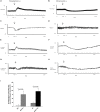Involvement of GABAergic and Adrenergic Neurotransmissions on Paraventricular Nucleus of Hypothalamus in the Control of Cardiac Function
- PMID: 29915544
- PMCID: PMC5994789
- DOI: 10.3389/fphys.2018.00670
Involvement of GABAergic and Adrenergic Neurotransmissions on Paraventricular Nucleus of Hypothalamus in the Control of Cardiac Function
Abstract
Sympathetic premotor neurons of the paraventricular hypothalamus (PVN) play a role in hemodynamics adjustments during changes in body fluid homeostasis. However, PVN contribution to the tonic control of cardiac function remains to be systematically studied. In this study, we assessed whether GABAergic and adrenergic synapses, known for being active in the PVN, are involved in the control of cardiac function. Adult male Wistar rats (250-350 g; n = 27) were anesthetized with urethane (1.2-1.4 g/kg i.p.) and underwent catheterization of femoral artery to record blood pressure and heart rate. The femoral vein was used to inject the vasoactive agents phenylephrine (10 μg/kg) and sodium nitroprusside (10 μg/kg) and to supplement anesthesia. The cardiac left ventricle was catheterized to record left ventricular pressure and its derivative. Craniotomy allowed for injections (100 nL) into the PVN of: muscimol (20 mM), bicuculline methiodide (0.4 mM), propranolol (10 mM), isoproterenol (100 μM), phentolamine (13 mM), phenylephrine (30 nM). We found that: (i) inhibition of PVN by muscimol, reduced arterial pressure, cardiac chronotropy and inotropy; (ii) disinhibition of PVN neurons by bicuculline evoked positive chronotropy and inotropy, and increase blood pressure; (iii) PVN alpha adrenergic receptors control cardiac chronotropy and inotropy; (iv) beta adrenergic receptors of the PVN do not influence cardiac function; (v) afterload does not contribute to the PVN-evoked inotropy. Our results indicate that the modulation of the activity of PVN neurons exerted by GABAergic and adrenergic mechanisms contribute to the control of cardiac function.
Keywords: autonomic nervous system; cardiac contractility; cardiac function; paraventricular nucleus; sympathetic nervous system.
Figures








Similar articles
-
Ventromedial medullary pathway mediating cardiac responses evoked from periaqueductal gray.Auton Neurosci. 2020 Nov;228:102716. doi: 10.1016/j.autneu.2020.102716. Epub 2020 Aug 12. Auton Neurosci. 2020. PMID: 32882606
-
Possible role of adrenoceptors in the hypothalamic paraventricular nucleus in corticotropin-releasing factor-induced sympatho-adrenomedullary outflow in rats.Auton Neurosci. 2017 Mar;203:74-80. doi: 10.1016/j.autneu.2017.01.008. Epub 2017 Feb 9. Auton Neurosci. 2017. PMID: 28202248
-
Changes in GABAergic inputs in the paraventricular nucleus maintain sympathetic vasomotor tone in chronic heart failure.Auton Neurosci. 2012 Nov 2;171(1-2):41-8. doi: 10.1016/j.autneu.2012.10.005. Epub 2012 Nov 10. Auton Neurosci. 2012. PMID: 23146621
-
A role for the paraventricular nucleus of the hypothalamus in the autonomic control of heart and kidney.Exp Physiol. 2005 Mar;90(2):169-73. doi: 10.1113/expphysiol.2004.029041. Epub 2004 Dec 16. Exp Physiol. 2005. PMID: 15604110 Review.
-
Effects of stimulation of the hypothalamic paraventricular nucleus on blood pressure and renal sympathetic nerve activity.Brain Res Bull. 1988 Jun;20(6):779-83. doi: 10.1016/0361-9230(88)90091-3. Brain Res Bull. 1988. PMID: 2900671 Review.
Cited by
-
BDNF downregulates β-adrenergic receptor-mediated hypotensive mechanisms in the paraventricular nucleus of the hypothalamus.Am J Physiol Heart Circ Physiol. 2019 Dec 1;317(6):H1258-H1271. doi: 10.1152/ajpheart.00478.2019. Epub 2019 Oct 11. Am J Physiol Heart Circ Physiol. 2019. PMID: 31603352 Free PMC article.
-
Prenatal Morphine Exposure Increases Cardiovascular Disease Risk and Programs Neurogenic Hypertension in the Adult Offspring.Hypertension. 2023 Jun;80(6):1283-1296. doi: 10.1161/HYPERTENSIONAHA.122.20262. Epub 2023 Apr 12. Hypertension. 2023. PMID: 37042247 Free PMC article.
-
Contribution of DNA methylation in chronic stress-induced cardiac remodeling and arrhythmias in mice.FASEB J. 2019 Nov;33(11):12240-12252. doi: 10.1096/fj.201900100R. Epub 2019 Aug 30. FASEB J. 2019. PMID: 31431066 Free PMC article.
-
The Lateral Hypothalamus: An Uncharted Territory for Processing Peripheral Neurogenic Inflammation.Front Neurosci. 2020 Feb 12;14:101. doi: 10.3389/fnins.2020.00101. eCollection 2020. Front Neurosci. 2020. PMID: 32116534 Free PMC article. Review.
-
The Role of the Paraventricular-Coerulear Network on the Programming of Hypertension by Prenatal Undernutrition.Int J Mol Sci. 2022 Oct 8;23(19):11965. doi: 10.3390/ijms231911965. Int J Mol Sci. 2022. PMID: 36233268 Free PMC article. Review.
References
-
- Bachelard H., Harland D., Gardiner S. M., Kemp P. A., Bennett T. (1992). Regional haemodynamic effects of noradrenaline injected into the hypothalamic paraventricular nuclei of conscious, unrestrained rats: possible mechanisms of action. Neuroscience 47 941–957. 10.1016/0306-4522(92)90042-Z - DOI - PubMed
LinkOut - more resources
Full Text Sources
Other Literature Sources

